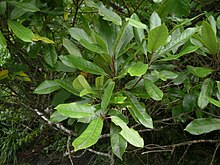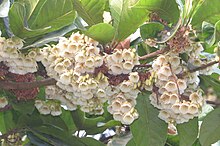Elaeocarpus is a genus of nearly five hundred species of flowering plants in the family Elaeocarpaceae native to the Western Indian Ocean, Tropical and Subtropical Asia, and the Pacific. Plants in the genus Elaeocarpus are trees or shrubs with simple leaves, flowers with four or five petals usually, and usually blue fruit.
| Elaeocarpus | |
|---|---|

| |
| Elaeocarpus hainanensis flowers | |
| Scientific classification | |
| Kingdom: | Plantae |
| Clade: | Tracheophytes |
| Clade: | Angiosperms |
| Clade: | Eudicots |
| Clade: | Rosids |
| Order: | Oxalidales |
| Family: | Elaeocarpaceae |
| Genus: | Elaeocarpus L.[1] |
| Type species | |
| Elaeocarpus serratus | |
| Species | |
| Synonyms | |





Description
editPlants in the genus Elaeocarpus are mostly evergreen trees or shrubs, a few are epiphytes or lianes, and some are briefly deciduous. The leaves are arranged alternately, simple (strictly compound with only one leaflet) with a swelling where the petiole meets the lamina, often have toothed edges, usually have prominent veins and often turn red before falling. The flowers are usually arranged in a raceme, usually bisexual, have four or five sepals and petals and many stamens. The petals usually have finely-divided, linear lobes. The fruit is an oval to spherical drupe that is usually blue, sometimes black, with a sculptured endocarp.[2][3][4]
Taxonomy and naming
editThe genus Elaeocarpus was first formally described in 1753 by Carl Linnaeus in Species Plantarum,[5][6] although Johannes Burman published an illustration of "Elaecarpus serrata" in his book Thesaurus zeylanicus, but without a description of the genus.[7] The first species described by Linnaeus (the type species) was Elaeocarpus serratus.[5] The name Elaeocarpus is derived from Greek and means ‘olive-fruited’.[8]
Species
editSee also List of Elaeocarpus species
There are about 488 species of Elaeocarpus, found on the islands of the western Indian Ocean, in tropical and subtropical Asia, Australia and on Pacific islands.[9]
Selected species
edit- Elaeocarpus acmosepalus Stapf ex Ridl.
- Elaeocarpus amoenus Thwaites - (Sri Lanka)
- Elaeocarpus angustifolius Blume - (India, Bangladesh, China, Indochina, Indonesia, Australia, Papua New Guinea and surrounding islands)
- Elaeocarpus arnhemicus F.Muell. - (northern Australia, New Guinea)
- Elaeocarpus bancroftii F.Muell. & F.M.Bailey - (Queensland)
- Elaeocarpus bifidus Hook. & Arn. - Hawaiian Islands (Kauaʻi & Oʻahu)
- Elaeocarpus blascoi Weibel - (India, threatened)
- Elaeocarpus bojeri R.E.Vaughan - (Mauritius)
- Elaeocarpus brigittae Coode - (Sumatra)
- Elaeocarpus calomala (Blanco) Merr. -
- Elaeocarpus carolinae B.Hyland & Coode - (north-east Queensland)
- Elaeocarpus ceylanicus (Arn.) Mast. - (Sri Lanka)
- Elaeocarpus colnettianus Guillaumin - (New Caledonia)
- Elaeocarpus cordifolius Coode - (Kalimantan, Sarawak)
- Elaeocarpus coriaceus Hook. - (Sri Lanka)
- Elaeocarpus costatus M.Taylor - (Lord Howe Island)
- Elaeocarpus cruciatus Corner - (Malaysia, threatened)
- Elaeocarpus culminicola Warb. - (New Guinea, Queensland)
- Elaeocarpus dentatus (J.R.Forst. & G.Forst.) Vahl - (New Zealand)
- Elaeocarpus dinagatensis Merr. - (Philippines)
- Elaeocarpus eriobotryoides Ridl. - (Malaysia)
- Elaeocarpus eumundi F.M.Bailey - (Australia)
- Elaeocarpus ferrugineus (Jack) Steud. - (Malaysia, Borneo)
- Elaeocarpus fraseri Coode - (Malaysia)
- Elaeocarpus gaussenii Weibel - (India, critically endangered)
- Elaeocarpus gigantifolius Elmer - (Philippines)
- Elaeocarpus glandulifer (Hook. ex Wight) Mast. - (Sri Lanka)
- Elaeocarpus grandis F.Muell. – blue quandong (New South Wales, Queensland)
- Elaeocarpus griffithii (Wight) A.Gray – (Island and mainland Southeast Asia)
- Elaeocarpus hedyosmus Zmarzty - (Sri Lanka)
- Elaeocarpus holopetalus F.Muell. – (New South Wales, Victoria, Australia)
- Elaeocarpus homalioides Schltr.
- Elaeocarpus hookerianus Raoul – (New Zealand)
- Elaeocarpus hygrophilus Kurz – (Thailand)
- Elaeocarpus inopinatus Coode – (Borneo)
- Elaeocarpus integrifolius Lam. – (Mauritius)
- Elaeocarpus joga Merr. – (Mariana Islands, Palau)
- Elaeocarpus kirtonii F.Muell. ex F.M.Bailey – silver quandong (New South Wales, Queensland)
- Elaeocarpus lanceifolius Roxb. – (Tropical Asia)
- Elaeocarpus miriensis Weibel
- Elaeocarpus montanus Thwaites – (Sri Lanka)
- Elaeocarpus moratii Tirel
- Elaeocarpus munroi (Wight) Mast.
- Elaeocarpus nanus Corner
- Elaeocarpus obovatus G.Don – (Australia)
- Elaeocarpus obtusus Blume
- Elaeocarpus prunifolius (Müll.Berol.) Wall. ex Mast.
- Elaeocarpus pseudopaniculatus Corner
- Elaeocarpus recurvatus Corner
- Elaeocarpus reticosus Ridl.
- Elaeocarpus reticulatus Sm. – blueberry ash (eastern Australia)
- Elaeocarpus royenii Weibel
- Elaeocarpus rugosus Roxb. ex G.Don
- Elaeocarpus sedentarius Maynard & Crayn
- Elaeocarpus serratus L. – (South Asia)
- Elaeocarpus simaluensis Weibel
- Elaeocarpus stipularis Blume – (Indo-China, Malaysia)
- Elaeocarpus subvillosus Arn. – (Japan, Taiwan, China, Indochina).
- Elaeocarpus sylvestris (Lour.) Poir.
- Elaeocarpus symingtonii Ng
- Elaeocarpus taprobanicus Zmarzty – (Sri Lanka)
- Elaeocarpus thorelii Pierre – (Cambodia)
- Elaeocarpus venustus Bedd.
- Elaeocarpus williamsianus Guymer – hairy quandong (New South Wales)
References
edit- ^ "Elaeocarpus L." International Plant Names Index. Retrieved 5 February 2021.
- ^ Jeanes, Jeff A. "Elaeocarpus". Royal Botanic Gardens, Victoria. Retrieved 5 February 2021.
- ^ Crayn, Darren M.; Gardner, C.; Murray, Louisa. "Genus Elaeocarpus". Royal Botanic Garden Sydney. Retrieved 5 February 2021.
- ^ Phoon, Sook-Ngoh (2015). Systematics and biogeography of Elaeocarpus (Elaeocarpaceae) (MSc). James Cook University.
- ^ a b "Elaeocarpus". Australian Plant Census. Retrieved 5 February 2021.
- ^ Linnaeus, Carl (1753). Species Plantarum. Berlin. p. 515. Retrieved 5 February 2021.
- ^ Burman, Johannes (1747). Thesaurus zeylandica. p. 93. Retrieved 5 February 2021.
- ^ Gledhill, David (2008). The Names of Plants. Cambridge: Cambridge University Press. p. 150. ISBN 9780521866453.
- ^ "Elaeocarpus". Plants of the World Online. Retrieved 5 February 2021.